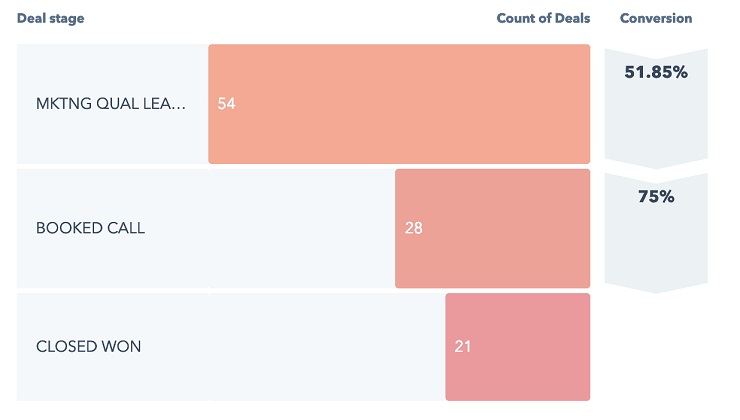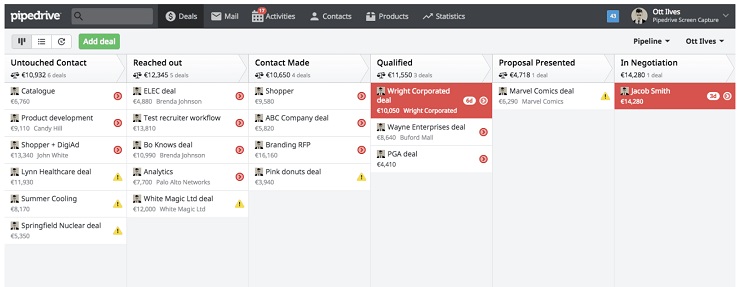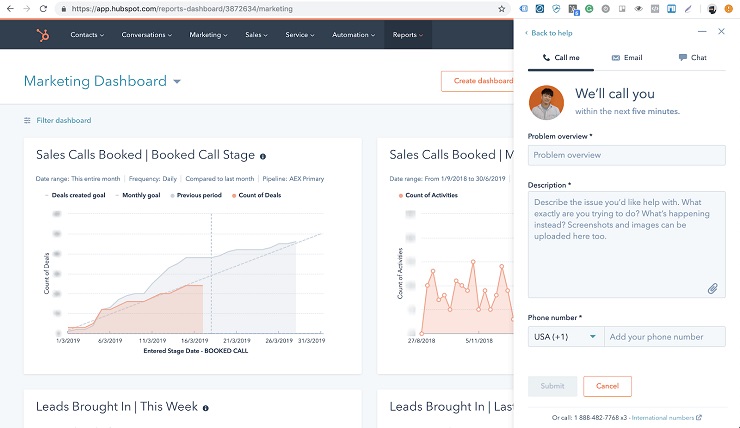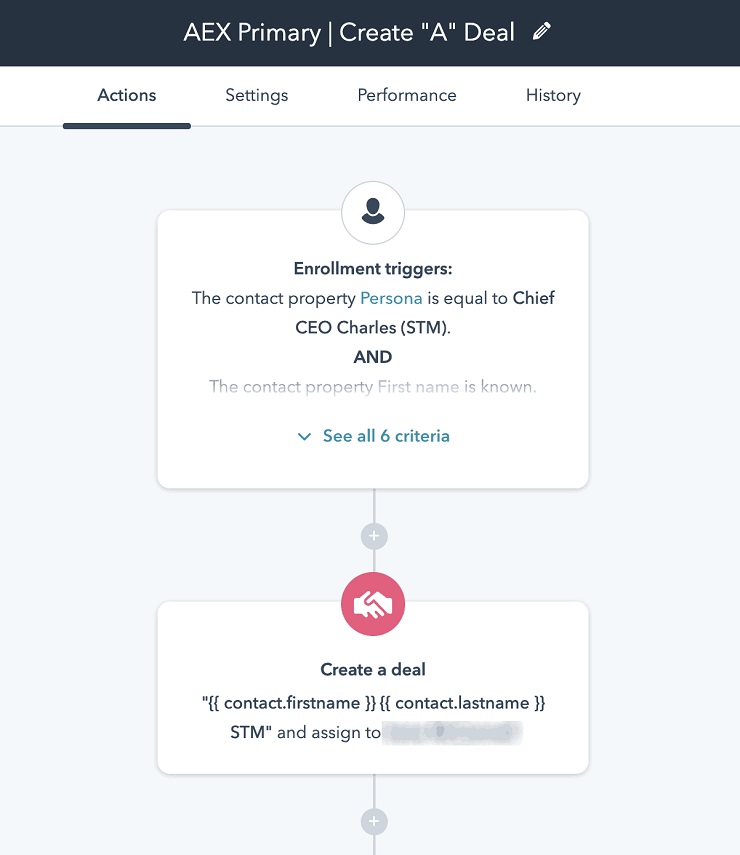So, your business is up and running, and making a nice chunk of revenue. Congratulations! However, you’re still keeping track of your leads and clients in a creaky old spreadsheet you’ve been using since day one. Or, worse, you’re managing your entire business out of your inbox.
What could go wrong?
Well, maybe nothing. I certainly know of businesses that are turning over $25 million in revenue—and they still use spreadsheets for their customer relationship management (CRM).
But the absence of headaches (so far) is not a good reason for avoiding innovation.
A modern CRM should have the ability to track every action of your leads and clients, from the moment they become aware of your business until they become a lifelong evangelist of your brand. It should also include automation, analytics, and inbox management tools and offer you solutions to headaches you didn’t even know you had. In fact, most business owners completely misunderstand the purpose of having a great CRM.
If you were to ask a dozen entrepreneurs what a CRM even is, you’d get responses like these:
- “It’s a marketing tool.”
- “It’s a database of your client data.”
- “It’s a business automation tool.”
- “It’s a pipeline management tool.”
- “It’s an overpriced piece of subscription software.”
None of these responses are completely wrong, but all of them miss the point.
For you, the business owner, a CRM represents something else altogether—a source of competitive advantage.
In other words, a CRM is a platform, as well as a set of related processes, data points, and skills that enable you to outsmart and outmaneuver your competitors. It can make your business any (or all) of the following:
- more responsive
- less expensive
- more reliable
- easier to use
- faster
- smarter
- more consistent
- more scalable
If any one of those things sounds like something you’d like to accomplish, I highly recommend putting some time into choosing and implementing the right CRM now.
And if that sounds a little overwhelming, fear not, I’ll walk you through all of the major factors you need to consider to implement a CRM that has your business humming along at top performance, running circles around your competition, and maximizing your clients and revenue.
Here’s a list of my best advice when choosing your CRM.
EXCLUSIVE FREE TRAINING: Successful Founders Teach You How to Start and Grow an Online Business
1. Build It Before You Need It
If you begin to implement a CRM in your business too early, you may spend money that would be better spent elsewhere. That includes the most important activity for an early-stage startup—nailing your product-market fit.
At the same time, if you delay CRM implementation for too long, you’ll incur a significant amount of operational debt (i.e., a debt you incur in the form of operational inefficiencies, which you must “repay” at a later date by investing resources into their removal or minimization), which will appear in the form of bottlenecks and inefficiencies.
Common staffing problems like team conflict and missed targets can also often be traced back to poorly timed CRM implementation.
This HubSpot dashboard demonstrates how a CRM can provide insights which save time and prevent team conflict (Source: HubSpot.com).
At Arielle Executive, we used a spreadsheet CRM until we were doing just under $1 million in revenue, and in hindsight I wish we had acted sooner (you can learn more about our story, the challenges we faced and lessons we learned here).
The spreadsheet we used was very comprehensive (read: complex), and captured contact data, lead quality, inquiry sources, taxes payable, revenue, numbers of sales calls, referrals, and so on. But because it was so comprehensive, it was also creaky, slow, and prone to crashing.
It also limited what we could do with our data. For example, it may have held the record that Bob Jones made an inquiry on April 23, 2019. But so what? The real value of this data lies in the ability to trigger automations based on it, to leverage it across the entire business, and to report on it.
This is why at our new baby startup, Exceptional Resume Writers, we had a CRM in place before the first dollar came through the door. The exact point when you should implement a CRM will, of course, vary from business to business and from industry to industry.
In the past, there was a strong case for delaying this decision, due to high setup fees. I remember having to pay $3,000 up front for an installation of Infusionsoft in one of my first businesses!
Fast forward to today and a lot of platforms either have low or non-existing financial barriers to entry (Infusionsoft included). You can find a solution that will scale with your business and allow you to, effectively, only pay for the functionality that you use.
To decide whether it’s the right time to implement a CRM, ask yourself: Is the cost of a CRM less than the cost of your current inefficiencies?
Also, plan ahead. Are your inefficiencies growing at an increasingly faster rate? If so, at which point do you feel they’ll become unacceptable?
Finally, consider opportunity cost. Can a CRM unlock value in a way that, effectively, helps it pay for itself?
I know that these questions can be difficult to answer. That’s because, if your business doesn’t yet have a CRM, it’s quite unlikely that you have the metrics or dashboards in place that would alert you to such rising inefficiencies.
The good news is, you don’t need fancy data crunching or tech to figure out these answers.
Just sit down with your bank accounts and a spreadsheet and use them to calculate your gross profits and margins. If you want to get fancy—and particularly if you’re a SaaS business—calculate your LTV:CAC ratio as well.
2. Hire the Right People to Implement Your CRM
Implementing a CRM will likely be the first time you need to have a dedicated operations function in your business, meaning one or more people tasked with the administrative details that make the business run smoothly. In other words, someone keeping the trains running on time.
If you don’t have a dedicated operations person in the business, it helps to recognise that decisions about CRM implementations should be made through the eyes of this kind of team member. It takes a certain kind of mind. If you have that proclivity yourself and it makes strategic sense for you to lead this, then go for it.
However, if you don’t have an “ops brain,” find someone who does. Just make sure that the person you put in charge of the project has visibility of your entire business and the authority to change processes at the strategic level.
This is vital, because CRM implementation should not be a simple, mindless transplant of your existing processes into your shiny new software. Nor should it be an opportunity to cater to all whims of your sales, marketing, and product teams.
Rather, it’s a top-down process that will use this new technology to improve the efficiency of your business and unlock new levels of value. It’s an opportunity to think holistically about how you do business, and to build new systems that will scale with your growth.
Most importantly, a sound CRM implementation involves decisions that consider the entire business—not just a specific function—and will make tradeoffs (and there will always be tradeoffs) that make strategic sense.
Addressing the Technical Aspects
You also need to make sure you have the right people in place to help you with the technological aspects of the implementation.
If you’re doing a straightforward, early stage CRM migration, you can probably do it yourself, even if you’re not “techy.”
However, if you’re already doing more than a few hundred thousand dollars in revenue, you’re probably already running a few different plugins, analytics, shopping cart, processor, accounting software, and so on.
Some of these may become redundant as your CRM takes over their functions, but others will need to be integrated into it. This means you’ll probably need the help of a developer who is experienced at API integrations. It’s going to get a little messy.
Make sure that you the person you bring on board is at least at the level of a senior developer. Do not trust outsourcing this process to a $15/hr beginner.
Also, it’s desirable that the developer you choose, beyond coding skills, has some business intelligence, reporting, and data visualization experience. Experience with specific CRM and applications that you’re planning to integrate will help a lot, too.
I’ve personally hired very competent developers, well-suited for this kind of project, on Upwork for $70-120/hr. If your business is complex, is turning over more than a couple million dollars in revenue (and you have the budget for it), consider looking for developers on platforms like TopTal.
3. Choose a CRM With Great User Experience and Superb Customer Support
The definition of a “great CRM” is fairly fluid, and will depend on the type of business you run, its size, as well as the niche you operate in.
However there are two features which I believe are non-negotiable: user experience (UX) and customer support (CS).
Let’s discuss UX first.
The age of ugly user interfaces is over. Make sure your CRM’s design is friendly, simple and logical.
Pipedrive’s UI is not overly pretty, but is logical and clean (Source: Pipedrive.com).
Modern CRMs contain a lot of functionality and huge amounts of information, so a good CRM design doesn’t just look pretty—it presents the right information at the right time.
Today there’s no excuse for having a CRM that has clunky, stale UI that looks like it was built to manage Russian nuclear reactors.
Your team will rise up in protest.
Millennial employees, in particular, won’t use an ugly CRM, because they grew up with an iPhone attached to their hand and are accustomed to usable, sleek interfaces. The old timers will resist, because they’ll feel overwhelmed by unnecessary complexity.
What’s the best way to evaluate the interface of a particular CRM?
A somewhat humorous, but not necessarily unserious answer would be to ask your 12-year-old kid.
Definitely avoid asking everyone on the team for their opinion, or to gauge the quality of a UX through a democratic vote. Different people have different design chops, and not everyone will understand or appreciate the value of good design. Give more weight to opinions of digital natives and, above all, use common sense. If it looks clunky and confusing, it probably is.
Now, a few thoughts about customer support.
Choose a CRM vendor that has a friendly, legible, useful online knowledge base that shows how to configure the software and solve its common problems. This will help ensure that your team doesn’t interrupt you 15 times per day with basic support questions.
HubSpot gives you access to customer support from within the CRM (Source: HubSpot).
For more advanced issues, and you will experience them, you’ll need to contact your CRM provider’s support team.
Ideally, you want to be able to contact them in real time via chat, phone or email from within the app.
Having your issue resolved live via chat is infinitely more useful than being blocked by one overnight as you wait for someone to respond to an email support ticket.
Poke a few holes in their support team’s capabilities by asking them a few questions during your trial period. Pay attention to things like:
- How long are wait times?
- Are support staff trained well enough to solve your problems on the spot, or do they often need to “get back to you”?
4. Decide on a Fully Integrated vs. Basic CRM
Marketing and sales dysfunction is one of the biggest problems startup leaders face. This arises as a result of an entrenched divide between sales and marketing, and these usually form at the very beginning, when you’re designing your sales and marketing processes:
- Marketing and sales should be collaborating, but they aren’t.
- Sales says the leads from marketing aren’t good enough.
- You don’t know what your customer lifetime value (LTV) and cost per actions (CPAs) are.
- And that means you don’t know which marketing channel you should focus on growing.
One way to overcome this conflict is a fully integrated CRM platform that is capable of eventually powering your entire business. Unlike simple CRMs, these tend to include features that empower you to manage the entire customer lifecycle journey:
- Marketing automation
- Pipeline management
- Service ticketing
- Email marketing
- Forms
- Custom reports
- Chat bots
- Meeting tools
- Live chat
- Native integration with payment processors
- Templates and snippets
- Knowledge bases
- Surveys
EXCLUSIVE FREE TRAINING: Successful Founders Teach You How to Start and Grow an Online Business
1. Build It Before You Need It
The main players in this space are Zoho and HubSpot. Infusionsoft is also very capable, but I personally don’t tend to recommend it because I don’t like its interface (I was a user for over four years and never got used to it). All three have the capability to scale with your business needs, so you won’t be paying for features you don’t need.
Salesforce also deserves a mention here. It is an oddball because it’s the most expensive—even at its lowers pricing tiers—and its costs increase rapidly as you scale up. For your money, you really do get the ultimate in flexibility and scalability. Salesforce can be configured and adapted to suit the most complex business processes and environments. People who have a genuine need for this platform tend to know who they are.
“But these CRMs are so complex,” you might say. “A focused CRM is so much simpler.”
Not exactly. Fully integrated CRMs are more sophisticated, not more complex, which means they scale well. By the time you double your revenue, a “simple” CRM will be just one piece in a complex web of integrations, hacks, data exports, and manuals.
Even though most of them claim to integrate with just about everything, you’ll quite soon run into technological limitations, and won’t be able to make them talk to each other as well as a fully integrated system.
This means you miss out on valuable business intelligence, suffer from increased complexity, and increased reliance on bringing in specialists to help. The money you save on the simple CRM will be wasted in lost time, incomplete data, and countless contractor hours.
A fully integrated CRM, on the other hand, will effortlessly grow (and, if need be, shrink) with your business, without adding unnecessary complexity.
It will also allow you to collect, store and leverage data of the entire customer journey, which will help you improve your team’s’ collaboration and productivity, increase sales and heighten customer satisfaction.
Your CRM Is Live—Now What?
So, you’ve used my checklist to choose and implement your new CRM. Congrats! To make sure you get the greatest ROI, follow these three bonus tips.
Become a Master of Data
“In God We Trust, All Others Bring Data”
— framed plaque, NASA’s Johnson Space Center
Whether you know it or not, your business is a digital business. Even if you are a clothes retailer with physical storefronts, you’re really a digital business with storefronts, not a retail business with a digital sales channel.
This is an important distinction, because in a digital business, data is an immense source of competitive advantage. And the key to collecting, storing, and leveraging data is an effective CRM system.
We, for example, use our HubSpot CRM to track the entire lifecycle journey of a customer. At the top of the funnel, we track the Google Ads and organic keywords that generate leads, and feed those into the CRM.
On the other end of the funnel, we track NPS scores of our customers. Those pieces of data are powerful on their own, but they become infinitely more powerful when they are under the roof of one CRM, which means they offer insights to questions like:
- Is there a relationship between advertising copy and customer happiness?
- Which ad campaigns are generating the happiest customers? Why?
This is important, because one of the biggest reasons businesses leave money on the table is a divide between their marketing and fulfilment teams. Ambitious marketers can use clever psychology to generate leads, which look great on the surface, and are certainly likely to buy. However, they do so by subtly overselling and overpromising.
This causes no problems until the business owner sees a spike in dissatisfied customers. The temptation can be to point the finger at the fulfillment team, but it’s often the case that the problem began long before fulfilment team met the client.
Create Scalable Lead-Handling Processes
A modern CRM has many functions, but one of its vital tasks is to help you make sense of, grade, prioritize, and respond to, incoming leads.
Do not, I repeat, do not build CRM processes that put you—the founder aka chief salesperson, aka chief of everything else—on the hook for answering all questions from all inquiries, in real time.
That approach is useful at the idea/seed stage, because it forces you to keep your ear very close to the ground, but by the time you reach $100,000 in revenue, you should have a feel for which inquiries are worth your time and which aren’t—and which markers indicate their worth to you.
Here are some tips to get you started:
- Create a lead-grading system, which you can use to grade the quality of your inbound contacts into tiers based on their characteristics. For example, if you’re a B2B merchant of computer hardware, then an inquiry from a head of IT at Westpac would score an A, while an inquiry from a CEO of a five-person startup would score a B, and one from a random psychology student would score a C.
- Leverage your CRM’s automation to communicate with these leads in targeted and scalable ways. For example, an A-quality lead may get an email that contains a lot of proof, authority, and a meeting link which enables them to book an appointment in your schedule. A B-quality lead may get an email that gently qualifies them, while a C-quality lead may get a polite “Thanks, but you’re in the wrong place” email.
- Create targeted follow-up sequences that are triggered by subsequent actions (or inactions) of your leads.
The greater point is, you need to leverage what your CRM is capable of to build a scalable lead management system that triages incoming leads and lets you to stay in control of your workday. If you don’t, you’ll drown in pointless emails and nonsensical conversations.
Hubspot automation enables you to stay in control of your inbound leads (Source: HubSpot.com).
For example, you should certainly be jumping on the phone with qualified leads that fit your target market criteria and have expressed a degree of commercial interest in your products/services.
However, you should not be picking up the phone in real time and fielding random people’s questions. You’ll find that 70% of that time is wasted, and does not lead to sales. Find a way to solve that problem, either by using highly scalable solutions like knowledge bases or low-cost solutions like virtual assistants.
Some of the queries can be answered by knowledge bases. Some CRMs have those built-in. Some can be outsourced/redirected to a virtual assistant service.
We, for example, redirect all calls to such a service. They take a message via a form that is integrated with our CRM. Automation takes care of the rest—as soon as the form is filled out, a task is created in our CRM.
Use Your New CRM To Test. Everything.
People will give you all kinds of marketing and sales advice. You should be open to all of it, and you may implement and test a lot of it, too. But make sure you can test its validity through data. I don’t care if Gary Vee personally tells you to do something—make sure you can measure the validity of his advice, and only keep it if it produces measurable, relevant results.
For example, a number of freelance marketers and agencies have advised us to put phone number CTAs more prominently on our website. Create a prominent top banner with a phone number in it, they said. Make it red, they said. Make it easy for website visitors to call you, they said.
We followed their advice, and it was certainly true; more people began to call. However, a curious thing also happened. While the inquiry rate increased, the lead quality dropped. Which means overall revenue also dropped. But the salesperson’s wages went up.
Become a master of data. I highly recommend the book Web Analytics 2.0 by Avinash Kaushik as a primer. While it doesn’t deal directly with CRM technology, it will challenge your thinking in a way that will help you build more scalable, efficient, and powerful CRM processes.
EXCLUSIVE FREE TRAINING: Successful Founders Teach You How to Start and Grow an Online Business
1. Build It Before You Need It
Remember, Great CRM is a Competitive Advantage
Hopefully, you are now armed with plenty of information to help you choose the right CRM and leverage it to boost your business.
What are your thoughts on implementing a business CRM? I’d love to hear which platforms you chose in the end, and how they’re working out for you. Let me know in the comments.




















